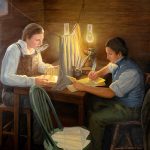| 1 | |
|---|---|
 | |
| Born | July 5, 1801 Farragut, Tennessee, U.S. |
| Died | August 14, 1870 (aged 69) Portsmouth, New Hampshire, U.S. (now Kittery, Maine, U.S.) |
Associated Locations:
- Campbell’s Station, Tennessee
Associated Dates:
- June 5, 1801 – Born
Life Sketch from The Other Eminent Men of Wilford Woodruff
Copyright © Taken from the book: The Other Eminent Men of Wilford Woodruff. Special thanks to Vicki Jo Anderson. Please do not copy.
American Naval Officer 1801-1870
Admiral David Farragut is one of the eminent spirits who appeared to President Wilford Woodruff in the St. George Temple on August 21, 1877. This interesting story is detailed in the Eminent Spirits Appear to Wilford Woodruff wiki.
“In the civil war, control of the sea was priceless asset in the union. The navy maintained communications with the outside world, severed those of the South, captured important points on the coast, and on the Western rivers cooperated with the army like a blade to a pair of shears.” Filling such a role in American naval history was Admiral David Glasgow Farragut.
Farragut’s dignity of character and simplicity of heart combined with his profound submission to the Almighty makes his life worthy of emulation.
“God forbid, that I should have to raise my hand against the South.”
– Admiral David Glasgow Farragut
Early Life

David Porter
After the United States completed the Louisiana Purchase, the family moved again to help settle New Orleans. One day his father returned home struggling with an elderly man he had resvued near the lake who was suffering from “heat prostration.” This singular incident led directly, both physically and mentally, to Farragut’s entrance in the navy. The sufferer, David Porter, had been a seaman and as young Farragut helped nurse him, he listened to Porter’s stories of the sea. Farragut began to dream of going to sea.In March 1776, George Farragut, David’s father, immigrated from his native island of Minorca, in the Mediterranean Sea, to America. Of Spanish decent, George Farragut arrived to find America deep in Revolutionary War. Farragut’s father immediately devoted himself to the cause of the colonists and served gallantly in the war. He served first as a cavalry officer and later in the navy. When the war ended he took his family to settle in the wilderness of Tennessee. It was here that David Glasgow Farragut was born. Life in the frontier was not only rugged but also extremely dangerous. David recalls a time when his mother sent him aloft to watch an approaching Indian Party while she stood ready at the barricaded door with an axe.
Mr. Porter did not recover but died while in the care of the Farraguts. Mrs. Farragut had contracted yellow fever while Porter was there and she died also. The funerals of the two were held the same day. Although life was harsh for settlers on the frontier, its very harshness gave strength and hardiness to a youth of spirit.
Commander Porter, son of Mr. Porter, soon visited the family and offered to adopt young Farragut. Dazzled by the Commander’s uniform and filled with a sense of destiny, young David agreed to go with Commander Porter and his family. Shortly thereafter nine-year-old David was sent to school in Washington, D.C., for there were few educational opportunities in Louisiana where the Porter family lived. He never saw his father again. He passed away before David could return home.
Attack on British Ships
In 1811, David was commissioned a midshipman and was ordered to serve the frigate ‘’Essex’’ which was under his mentor, Commodore Porter. Great Britain was harassing American commerce on the seas, so the Essex was sent to Valparaiso, Chile, to protect the American whaling shops from the British.
They captured several British shops and because of a shortage of officers young Farragut was made prize-master, or temporary captain, of one of those shops, the British whaler, the Barclay. His orders were to return from the coast of Peru to Chile. The captured English captain was greatly disturbed that a lad of thirteen was given command of the ship and he to overawe the boy into surrendering his authority.

The Essex fighting the British ship, Pheobe
When the day arrived for our separation from the squadron [Farragut wrote] the captain was furious, and very plainly intimated that I would find myself off New Zealand in the morning, to which I most decidedly demurred…. I was considered that my day of trial had arrived (for I was a little afraid of the old fellow, as everyone else was). But the time had come for me to at least to play the man: so I mustered up courage and informed the captain that I desired the main top sail filled away, in order that we might close up with the ‘’Essex Junior’’. He replied that he would shoot any man who dared to touch a rope without his orders … then he went below for his pistols. I called my right had man of the crew and told him my situation. I also informed him that I wanted the main top sail filled. He answered with a clear “Ay, ay, sir!” in a manner which was not to be misunderstood, and my Confidence was perfectly restored.
As Farragut returned to the ‘’Essex’’ in the harbor at Valparaiso, he participated in one of the bloodies battles in naval history. The British ships the ‘’Phoebe’’ and the ‘’Cherub’’ completely destroyed the ‘’Essex’’. Farragut was slightly wounded. Young as he was, Farragut seems to have distinguished himself in this engagement. His name is mentioned with honor as one of the officials who “exerted themselves in the performance of their respective duties, and gave an earnest of their value to the service.
In his fourteenth year, his orders separated him from his guardian. He was left to his own strength of character to guide his steps. In reflection, he gratefully recalled the influence of, first, a young first lieutenant named Cocke and, later, a messmate named William Taylor. Farragut noted of Taylor: “He …. counseled me kindly, and inspired me with sentiments of true manliness, which were the reverse of what I might have leard from the examples I saw in the steerage.
In 1815, Farragut’s orders sent him with a fleet to the Mediterranean. The following spring he was transferred to the ‘’Washington’’. The United States Minister to the Court, Mr. William Pinkney, was on board. This experience allowed him to round out his limited education. The travels of the squadron and his habit of observation did much to fill his mind with information that he had been unable to get earlier in his brief schooling. The chaplain in those days was often the only schoolmaster and the young midshipman had; and the degree of commitment to that schooling depended on the attitude of the Captain. In spite of these drawbacks, Farragut exhibited a natural desire to learn.
It was this characteristic as well as his ability to resist temptation that attracted him to Mr. Folsom, who , appointed to the consul of Tunis, obtained permission to take Farragut with him to Tunis for the winter. Here Farragut remained under Mr. Folsom’s tutelage for nine months, pursuing his studies on the site of the ancient maritime empire of Carthage. The subjects that were of particular interest to him were mathematics, English literature, French, and Italian. Mr. Folsom, who lived to the end of the Civil War, was able to follow the successful and great career of the young orphan boy he once befriended.
Farragut was not yet eighteen when he was appointed acting lieutenant on board the brig ‘’Shark’’. Reflecting on this event he recorded, “I consider it a great advantage to obtain command young, having observed, as a general rule, that persons who come into authority late in life shrink from responsibility, and often break down under its weight.”
Married Life
After four and a half years at sea, Farragut returned to the United States. He settled in Norfolk, Virgina, and married Susan C. Merchant, with whom he was very happy until she died after suffering a terrible illness. His devotion and his tenderness in assuring to his wife’s every comfort, through the sixteen years of her illness, was reported as a striking illustration of his gentleness of character. When not at sea, he was constantly by her side and proved himself a faithful and skillful nurse.
His kind and compassionate nature extended to all he knew. His inspiring admiration in all who interacted with him. A lady of Norfolk was reported to have said: “When Captain Farragut dies, he would have a monument reaching to the skies, made by every wife in the city contributing a stone.” After Susan’s death, Farragut married again, this time to a lovely southern belle, Virginal Loyall, by whom he had a son, Loyall.
After a thirteen-year absence, his orders allowed him to pay a visit to New Orleans to see his brother and sister. Ironically, the ship he was carried one carried the first load of briks to build Fort Jackson and New Orleans. Years later Farragut would attack this same fort, achieving the surrender of New Orleans during the Civil War.
Farragut spent the following years suppressing piracy in the west Indies. In August 1825, while commanding the famous ‘’Brandywine’’, he returned the great General Lafayette to France after his memorable visit to the United States. The time spent with this devoted patriot of freedom was of no minor consequence.
Farragut was always careful to see that his ship’s boys received their educational studies and were treated with respect. Many men, unaccustomed to such kindness, gave loyal support in return.
Civil War

David Farragut
The United States sent Farragut’s fleet to Mexico with the American Ambassador on board to help negotiate and observe the battle between France and Mexico. Here he was able to observe firsthand the taking of the fort of San Juan de Ulloa in Vera Cruz. The observations and analysis he made of the battle were helpful him years later in taking the forts of New Orleans and Mobile Bay.
Notwithstanding all that Farragut had been through, the Civil War proved to be perhaps the greatest test of principles he would ever pass through. Virginia was still wavering in her decision to secede, but while Farragut was home in Norfolk awaiting orders the South took Fort Sumpter. When President Lincoln ordered U.S. troops to retake it, the pro-secession party garnered enough votes to cause Virginia to leave the Union.
As a Virginian, Farragut felt great pride in and loyalty toward his state. He had seen what revolution had done to the countries in South America and dreaded the possibility of that type of destruction in his own land. He was not swayed by sentiment and reason but by the Constitution, the Union, and the destiny of the Republic. The day Virginia seceded, he was informed that because of his allegiance his life was not longer protected. “He at once went to his house and told his wife the time had come for her to decide whether she would remain with he own kinsfolk or follow him North. Her choice was as instant as his own that evening they, with their son, left Norfolk, never to return to it as their home.
The Navy Yard was in flames as they fled, narrowly escaping imprisonment. Part of the railroad tracks out of Baltimore were destroyed. This slowed the family’s departures. Then, when they finally arrived in New York they were met with suspicion. The people there needed time to learn to trust these Southerners. In spite of these difficulties. Farragut was soon working for the Navy department on a “retirement board” for older officers.
When the navy was reinforced by the building of additional ships, Farragut, then a captain, was ordered to the Gulf of Mexico to command a blockading squadron which would go up the Mississippi River to take New Orleans, his childhood home. New Orleans was guarded by two forts, Fort Jackson, and on the opposite bank, Fort St. Philip. Farragut and his fleet of seventeen vessels made a daring run past the two forts, subduing thirteen gunboats and two ironclads of the Confederate flotilla. Leaving Colonel Porter, grandson of David Porter, to accept the surrender of the two forts, Farragut proceeded with a portion of his fleet to New Orleans. New Orleans surrendered without a fight.
Farragut was then sixty years old, and he spent the next five years in constant blockade of the whole coast, except for Mobile, Alabama. Under his command was a fleet of eighty ships. Managing the commands of all these ships was a Herculean task. Farragut wrote wearily: “They must think that I am made of iron, … [but] as I am always hopeful; put my shoulder to the wheel with my best judgement, and trust to God for the rest.
Attack on Mobile Bay
Orders came for him to take the forts at Mobile Bay. The mouth of the bay was protected by two formidable forts, Fort Morgan and Fort Gaines. The narrow channel leading into the bay was obstructed by piling and lines of floating torpedos. Faragut’s fleet amounted to thirty ships. Against his better judgement Farragut allowed his officers to convince him to place his flagship third.
He gave the first ship orders to proceed around the torpedo’s in a narrow opening made for blockade runners. The captain disobeyed the orders and changed his course in pursuit of the southern ironclad, the ‘’Tennessee’’. A torpedo hit the shop, which sank quickly, taking with it the entire crew. The next ship, in fear and confusion, began backing up, and turning almost collided with Farragut’s flagship.

Attack at Mobile Bay
The great British naval officer. Lord Horatio Nelson, said: “Five minutes may make the difference between victory and defeat.” “Lost moments,” wrote Napoleon, “are the determining elements of naval campaigns.” The course of this battle depended upon the prompt decision of the admiral. Standing on the top deck Farragut appealed to Heaven for guidance. He recorded: “O God, who created man and gave him reason, direct me what to do. Shall I go on?” And it seemed as if in answer, he said, a voice commanded, “Go on!” God had spoken to him and personal danger could not deter him.
Edging his shop around the others and taking the lead, he shouted his now famous lines: “Damn the torpedo’s! Full speed!” As they passed between the buoys, many on board heard the casings of the torpedoes knocking against the copper of the ship’s bottom. Many of the primers snapped audibly, but no torpedo exploded.
During the battle for the fots, in order to get above the smoke of the battle to better direct the maneuvers of the fleet, Farragut took a position in the main rigging. He had the quartermaster lash him there so that if he were wounded or lost his footing, he would not fall to the deck.
In this engagement the Confederate fleet was destroyed, all ports to the South were closed, and twenty-six hundred prisoners were taken. This victory also helped re-elect President Abraham Lincoln. Lincoln’s presidential opponent, General George B. McClellan, a man whome Lincoln had dismissed as leader of the northern armies, had campaigned that Lincoln was a country bumpkin who did not know how to end a war he had started. The battle of Mobile Bay proved otherwise.
This battle was one of the greatest feats in naval history. Farragut differs from leaders of other great battles in one significant way. Civil War leaders Generals Grant and Sherman were not yet forty-five years old.
Nelson and Napoleon were but forty-six at Trafalgar and Waterloo. Farragut was sixty-one when New Orleans surrendered and sixty-five in the Battle for Mobile Bay. Bu age did not deter him, so excellent was his strength and stamina. As a reward for his brilliant achievement congress created the rank of “vice” admiral and conferred it upon Farragut.
Minorca
When the war ended Farragut was put in charge of the European fleet. This command allowed his wife to accompany him. Before he left on his European tour, Congress created the office of Admiral and the first ever in the United States. A grand reception was held for him on board his flagship. The President and many of his cabinet attended the party. Europe received Farragut with the honor befitting a hero. Everywhere he was received with honors, particularly from fellow naval officers. In England he was presented to Queen Victoria. But nowhere was he received with more acclamation that on the island of Minorca, the land of his ancestors. Going there filled his great desire to return to the land of his father. His personal secretary recorded that people thronged the street, each trying to get a better look at the admiral. The air filled with cheers and acclamations. The walls, housetops, and balconies were crowded with anxious onlookers. The force of the crowd became so great that Farragut’s [arty had to proceed on foot under armed guard. Arriving at the home they were to stay, Farragut went out on the second balcony and spoke to the crown in their native tongue. The crowed was deeply touched. “One old man with tears streaming down his weather-beaten face, stamped sincerity itself upon the nature of the welcome by shouting aloud: ‘He is ours! He is ours! But I shall never see him more.’ “
Farragut brought that honor not only to himself, his country, and his profession, but also to the land of his forefathers.
It had been said that Farragut had the energy and spirit of the ancient Vikings. Yet, after a battle when those who had been killed were laid out on the quarter deck for him to review, he wept like a little child. His biographer, Captain Mahan, wrote this tribute of him:
[Farragut] has left on record that, in the moment of greatest danger to his career [Mobil Bay], his spirit turned instinctively to God before gathering up its energies einto that sublime impulse whose luster, as the years go by, will more and more outshine his other deeds as the crowning glory of them all.
Copyright © Taken from the book: The Other Eminent Men of Wilford Woodruff. Special thanks to Vicki Jo Anderson. Please do not copy.2







